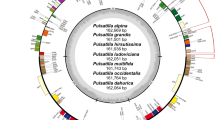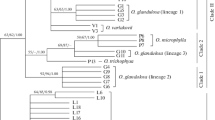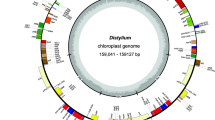Abstract
Chloroplast DNA restriction site variation was examined amongLepidium taxa usually classified in sects.Lepia, Lepiocardamon andCardamon. By using 15 restriction endonucleases, filter hybridization experiments, and comparative mapping procedures, a total of 119 variable restriction sites was detected. Of these, 56 were phylogenetically informative and were used in a cladistic analysis. The resulting phylogenetic tree agrees with results derived from morphology, isozyme electrophoresis and the analysis of glucosinolates. The data suggest: 1) The recognition of sect.Lepia, and 2) that sect.Lepiocardamon has close relationships to sect.Cardamon and that both should be amalgamated. Low rates of interspecific chloroplast DNA sequence divergence in sect.Lepia correlated well with morphological data and isoelectric focusing analysis of Rubisco, suggesting that taxa of sect.Lepia are closely related and most likely have diversified recently.
Similar content being viewed by others
References
Akeroyd, J. R., Rich, T. C. C., 1993:Lepidium. — InTutin, T. G. & al., (Eds): Flora Europaea1, 2nd edn, pp. 398–402. — Cambridge: Cambridge University Press.
Albert, V. A., Mishler, B. D., Chase, M. W., 1992: Character state weighting for restriction site data in phylogenetic reconstruction, with examples from chloroplast DNA. — InSoltis, P. S., Soltis, D. E., Doyle, J. J., (Eds): Molecular systematics of plants, pp. 369–401. — New York: Chapman & Hall.
Al-Shehbaz, I. A., 1986: The genera ofLepidieae (Cruciferae; Brassicaceae) in the southeastern United States. — J. Arnold Arbor.67: 265–311.
, 1987: Distribution and chemotaxonomic significance of glucosinolates in certain Middle-EasternCruciferae. — Biochem. Syst. Ecol.15: 559–569.
Boissier, E., 1867:Lepidium. — InBoissier, E., (Ed.): Flora Orientalis1, pp. 353–362. — Genève: H. Georg.
Bush, N. A., 1939:Lepidium. — InKomarov, V. L., Bush, N. A., (Eds): Flora of the U.S.S.R.8, pp. 374–391. — Moskva: Izd. Akad. Nauk. SSSR. English translation, Jerusalem 1970.
Cole, R. A., 1976: Isothyocyanates, nitriles and thiocyanates as products of autolysis of glucosinolates inCruciferae. — Phytochemistry15: 759–762.
Crawford, D. J., Palmer, J. D., Kobayashi, M., 1990: Chloroplast DNA restriction site variation and the phylogeny ofCoreopsis sect.Coreopsis (Asteraceae). — Amer. J. Bot.77: 557–558.
Doebley, J. F., Renfroe, W., Blanton, A., 1987: Restriction site variation in theZea chloroplast genome. — Genetics117: 139–147.
Doyle, J. J., Doyle, J. L., 1987: A rapid DNA isolation procedure for small quantities of fresh leaf tissue. — Phytochem. Bull.19: 11–15.
Farris, J. S., 1988: HENNIG 86. Version 1.5. Computer software and manual. — Port Jefferson station, N. Y. (publ. by author).
Felsenstein, J., 1985: Confidence limits on phylogenies: an approach using the bootstrap. — Evolution39: 783–791.
Greuter, W., Burdet, H. M., Long, G., (Eds), 1986: Med-Checklist. A critical inventory of vascular plants of the circum-mediterranean countries,3. — Geneve: Conservatoire et Jardin Botaniques and Med-Checklist Trust of OPTIMA.
Harris, S. A., Ingram, R., 1991: Chloroplast DNA and biosystematics: the effects of intraspecific diversity and plastic transmission. — Taxon40: 393–412.
Hewson, H. J., 1982: The genusLepidium L. (Brassicaceae) in Australia. — Brunonia4: 217–308.
Hillis, D. M., Bull, J. J., 1993: An empirical test of bootstrapping as a method for assessing confidence in phylogenetic analysis. — Syst. Biol.42: 182–192.
Hooker, J. D., Thomson, T., 1861: Praecursores ad Floram Indicam:Cruciferae. — J. Proc. Linn. Soc.5: 128–181.
Hurka, H., Freundner, S., Brown, A. H. D., Plantholt, U., 1989: Aspartate aminotransferase isozymes in the genusCapsella (Brassicaceae): subcellular location, gene duplication, and polymorphism. — Biochem. Genetics27: 77–90.
Jonsell, B., 1975:Lepidium L. (Cruciferae) in tropical Africa. — Bot. Not.128: 20–46.
Larson, S. R., Doebley, J., 1994: Restriction site variation in the chloroplast genome ofTripsacum (Poaceae): phylogeny and rates of sequence evolution. — Syst. Bot.19: 21–34.
Latowski, K., 1982: Taksonomiczne studium karpologiczne eurazjatyckich gatunkow rodzajuLepidium L. — Poznan: Adam Mickiewicz University Press.
Marais, W., 1970:Lepidium. — InCodd, L. E., De Winter, B., Killick, D. J. B., Rycroft, H. B., (Eds): Flora of southern Africa13, pp. 83–94. — Pretoria: Government Printer.
Mulligan, G. A., Frankton, C., 1962: Taxonomy of the genusCardaria with particular reference to the species introduced into North America. — Canad. J. Bot.40: 1411–1425.
Mummenhoff, K., Hurka, H., 1991: Isoelectric focusing analysis of Rubisco inLepidium (Brassicaceae), sectionsLepia, Lepiocardamon andCardamon. — Biochem. Syst. Ecol.19: 47–52.
, 1992: Systematics of AustralianLepidium species (Brassicaceae) and implications for their origin: evidence from IEF analysis of Rubisco. — Pl. Syst. Evol.183: 99–112.
, 1994: Chloroplast DNA restriction site variation and phylogenetic relationships in the genusThlaspi sensu lato (Brassicaceae). — Syst. Bot.19: 73–88.
Nei, M., Li, W., 1979: Mathematical model for studying genetic variation in terms of restriction endonucleases. — Proc. Natl. Acad. Sci. USA76: 5268–5273.
Palmer, J. D., 1987: Chloroplast DNA evolution and biosystematic uses of chloroplast DNA variation. — Amer. Naturalist130: 6–29.
, 1988: Chloroplast DNA variation and plant phylogeny. — Ann. Missouri Bot. Gard.75: 1180–1206.
Petersen, G., Doebley, J. F., 1993: Chloroplast DNA variation in the genusSecale (Poaceae). — Pl. Syst. Evol.187: 115–125.
Prantl, K., 1891:Cruciferae. — InEngler, A., Prantl, K., (Eds): Die natürlichen Pflanzenfamilien3 (2), pp. 145–206. — Leipzig: Engelmann.
Rieseberg, L. H., Beckstrom-Sternberg, S. M., Liston, A., Arias, D. M., 1991: Phylogenetic and systematic inferences from chloroplast DNA and isozyme variation inHelianthus sect.Helianthus (Asteraceae). — Syst. Bot.16: 50–76.
, 1991: Phylogenetic consequences of cytoplasmic gene flow in plants. — Evol. Trends Pl.5: 65–84.
Rollins, R. C., 1940: On two weedy Crucifers. — Rhodora42: 302–306.
Sandbrink, J. V., van Brederode, J., 1991: Different approaches to analysis of restriction fragment patterns of chloroplast DNA and phylogenetic relationships inSilene sect.Siphonomorpha (Caryophyllaceae). — Biochem. Syst. Ecol.19: 559–567.
Schultze-Motel, W., (Ed.), 1986:Lepidium. Illustrierte Flora von Mitteleuropa4 (1), 3rd edn, pp. 401–417, 590–591. — Berlin: Parey.
Schulz, O. E., 1936:Cruciferae. — InEngler, A., Prantl, K., (Eds): Die natürlichen Pflanzenfamilien17b, pp. 227–658. — Leipzig: Engelmann.
Solms-Laubach, H., 1906: Cruciferenstudien. IV. Die Varianten der Embryolage. — Bot. Zeitung64: 15–42.
Soltis, P. S., Soltis, D. E., Doyle, J. J., (Eds), 1992: Molecular systematics of plants. — New York: Chapman & Hall.
Swofford, D. L., 1991: PAUP. Phylogenetic analysis using parsimony, version 3.1 for Macintosh. Computer package. — Champaign, Ill.: Illinois Nat. Hist. Survey.
Sytsma, K. J., Gottlieb, L. D., Berry, P. E., 1991: The use of chloroplast DNA to assess biogeography and evolution of morphology, breeding systems, and flavonoids inFuchsia sect.Skinnera (Onagraceae). — Syst. Bot.16: 257–269.
Thellung, A., 1906: Die GattungLepidium (L.)R. Br. Eine monographische Studie. — Neue Denkschr. Allg. Schweizer Naturforsch. Ges.41: 1–304.
Turner, B. L., Kim, K.-J., 1990: An overview of the genusPyrrhopappus (Asteraceae) with emphasis upon chloroplast DNA restriction site data. — Amer. J. Bot.77: 845–850.
Warwick, S. I., Black, L. D., 1991: Molecular systematics ofBrassica and allied genera (subtribeBrassicinae, Brassiceae) — chloroplast genome and cytodeme congruence. — Theor. Appl. Genet.82: 81–92.
Watrous, L., Wheeler, Q., 1981: The outgroup comparison method of character analysis. — Syst. Zool.30: 1–11.
Zohary, M., 1966:Lepidium. — In: Flora Palaestina1, pp. 299–302. — Jerusalem: Israel Academy of Sciences and Humanities.
Zunk, K., Mummenhoff, K., Hurka, H., 1993: Chloroplast restriction site variation in theBrassicaceae tribeLepidieae. — Pl. Mol. Evol. Newsl.3: 40–44.
Author information
Authors and Affiliations
Rights and permissions
About this article
Cite this article
Mummenhoff, K., Kuhnt, E., Koch, M. et al. Systematic implications of chloroplast DNA variation inLepidium sectionsCardamon, Lepiocardamon andLepia (Brassicaceae). Pl Syst Evol 196, 75–88 (1995). https://doi.org/10.1007/BF00985336
Received:
Revised:
Accepted:
Issue Date:
DOI: https://doi.org/10.1007/BF00985336




